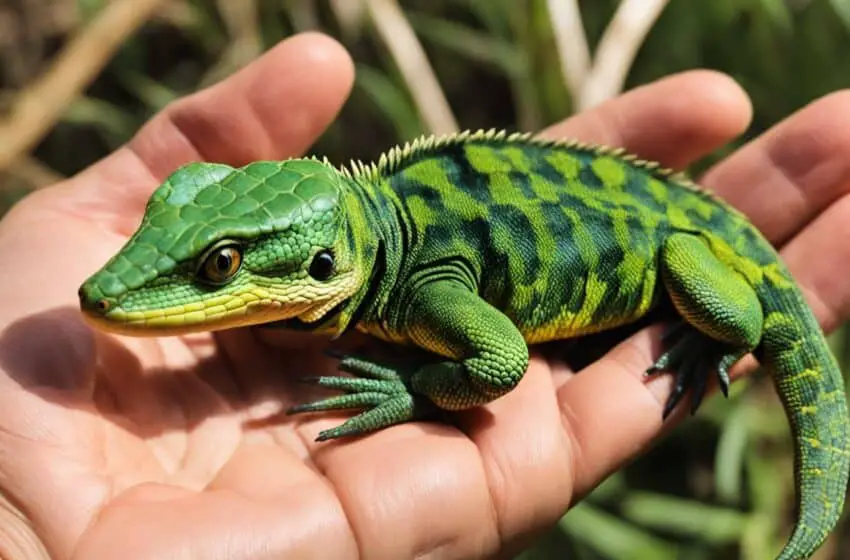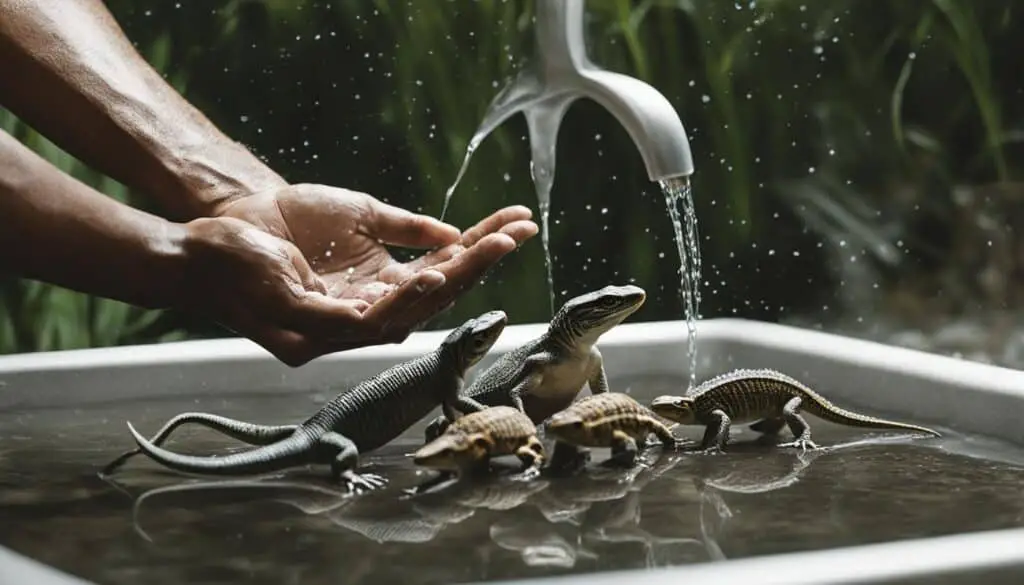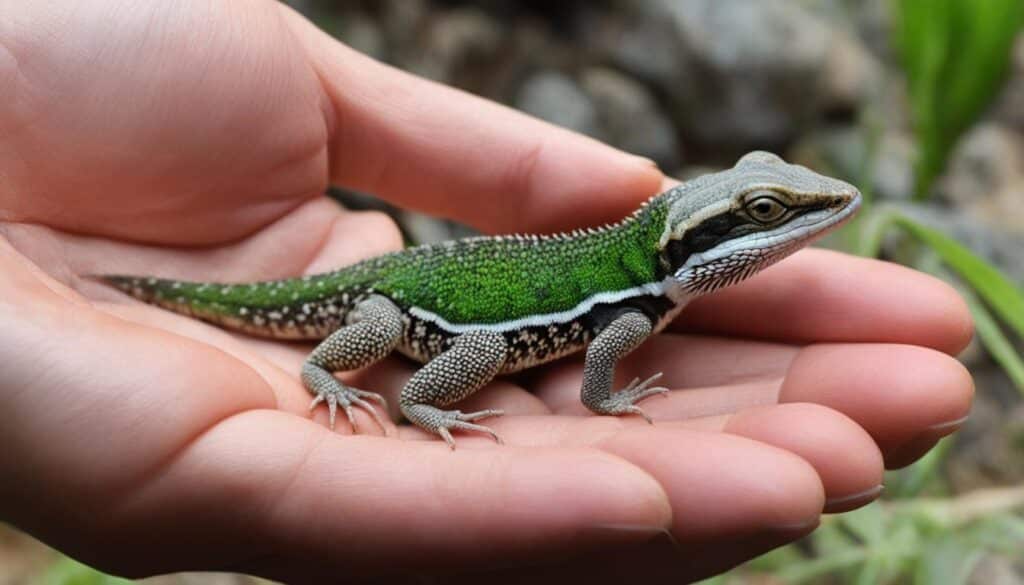The Do’s and Don’ts of Handling Small Pet Reptiles

As a responsible pet owner, it is crucial to prioritize the safe handling of small pet reptiles. These fascinating creatures can carry bacteria like Salmonella, which can be transmitted to humans through improper handling. To ensure a safe and enjoyable interaction with your scaly friend, it is important to follow certain guidelines.
Key Takeaways:
- Proper handwashing before and after handling reptiles is essential to reduce the risk of bacterial transmission.
- Use slow and gentle movements when handling reptiles to minimize stress and potential injury.
- Create an escape-proof and well-ventilated enclosure for your reptile to ensure its safety.
- Invest in appropriate handling equipment, such as snake hooks or tongs, to reduce direct contact with the reptile.
- Educate yourself about the specific needs and requirements of your reptile species to provide optimal care.
The Importance of Handwashing
When it comes to safe handling of small pet reptiles, one aspect that cannot be emphasized enough is proper handwashing. Handwashing is a crucial step in ensuring the health and safety of both the pet reptile and the pet owner. By following simple handwashing practices, you can reduce the risk of bacterial transmission and maintain a clean and hygienic environment for you and your scaly friend.
Before and after handling your reptile or any items in its enclosure, it is essential to wash your hands thoroughly. Use warm water and soap to create a rich lather. Take at least 20 seconds to scrub your hands, making sure to cover all areas, including the palms, back of the hands, and between the fingers. Pay extra attention to your fingertips, as they often come into direct contact with the reptile’s body.
Proper handwashing removes any potential bacteria that may be present on the reptile’s body or in its habitat. Many reptiles, including small pet reptiles like geckos, turtles, and snakes, can carry bacteria such as Salmonella, which can cause illness in humans. By washing your hands, you eliminate these bacteria, significantly reducing the risk of infection and keeping both you and your reptile healthy.
Remember, handwashing is not just crucial for your own safety but for others as well. If you have family members, especially young children or elderly individuals, who may come into contact with the reptile, it is vital for everyone to practice proper hand hygiene. This simple yet effective measure can protect the health of your loved ones and prevent the spread of harmful bacteria.
“Proper handwashing is a fundamental practice in safe reptile handling. It helps to eliminate potential bacteria and ensures the well-being of both the reptile and the pet owner.”
Make handwashing a routine part of your reptile care regimen. Encourage everyone in your household to follow these guidelines. By incorporating this simple yet powerful habit into your daily routine, you can enjoy the companionship of your small pet reptile while maintaining a clean and healthy environment.

| Key Points | Benefits |
|---|---|
| Thoroughly wash hands before and after handling your reptile | Reduces the risk of bacterial transmission |
| Use warm water and soap, scrubbing for at least 20 seconds | Eliminates potential bacteria present on the reptile’s body or in its habitat |
| Pay attention to all areas, including fingertips | Maintains a clean and hygienic environment |
| Encourage proper hand hygiene in your household | Protects the health of your loved ones |
Handling Techniques for Small Pet Reptiles
When it comes to handling small pet reptiles, using proper techniques is crucial to ensure their safety and well-being. By following these guidelines, you can reduce the risk of causing stress or harm to these delicate creatures. Here are some essential handling techniques to keep in mind:
Approach calmly and use slow, gentle movements
When approaching a small pet reptile, it’s important to remain calm and composed. Sudden movements or loud noises can startle the reptile, leading to stress or defensive behavior. Approach them slowly and use gentle movements, allowing them to acclimate to your presence.
“The key to successful reptile handling is patience and respect for their natural behaviors.” – Dr. Rebecca Anderson, Herpetologist
Properly support the body and limbs
When handling a small pet reptile, it’s crucial to support their body and limbs correctly. Different reptiles have varying body structures, so be mindful of their size and fragility. Support their body with one hand while gently holding their limbs to prevent unintentional injuries.
- Always support the body and limbs to avoid strain or discomfort.
- For small reptiles, use your fingertips to support their delicate limbs.
- For larger reptiles, use both hands to provide adequate support.
Avoid sudden movements
Sudden movements can startle small pet reptiles, potentially causing them to bite or scratch out of fear or self-defense. To prevent such reactions, it’s essential to avoid any sudden or jerky movements while handling them. Maintain a steady and controlled approach to create a sense of security and minimize stress for the reptile.
Remember, each reptile has its own unique temperament and handling preferences. Observing and understanding your pet’s behaviors will help you develop a better bond with them and ensure their overall well-being.
By practicing these handling techniques, you can promote a safe and positive interaction with your small pet reptile.

| Handling Techniques | Benefits |
|---|---|
| Approach calmly and use slow, gentle movements | Reduces stress and helps establish trust |
| Properly support the body and limbs | Prevents unintentional injuries and discomfort |
| Avoid sudden movements | Minimizes the risk of defensive behavior |
Enclosure Safety and Handling Equipment
Creating a safe and secure enclosure for your small pet reptile is essential to ensure their well-being and prevent any potential accidents. Here are some key tips to keep in mind:
1. Escape-Proof Enclosure
An escape-proof enclosure is crucial to prevent your small pet reptile from wandering off and getting lost or injured. Make sure the enclosure is secure and has a locking mechanism in place to prevent accidental openings. Regularly inspect the enclosure for any possible weak points or gaps that need to be addressed.
2. Adequate Ventilation
Proper ventilation is important to maintain good air quality within the enclosure. Ensure that there are enough air vents or openings to allow for proper airflow. This helps to prevent the buildup of humidity and reduces the risk of respiratory problems for your reptile.
3. Temperature and Lighting
Small pet reptiles require specific temperature and lighting conditions to thrive. Use appropriate heating elements such as heat pads or ceramic heat emitters to provide the necessary warmth. Additionally, install UVB lighting to mimic natural sunlight and aid in your reptile’s calcium metabolism. Monitor and adjust the temperature and lighting regularly to ensure they are within the recommended range for your specific reptile species.
4. Handling Equipment
Investing in proper handling equipment is essential for both your reptile’s safety and your own. Using snake hooks, tongs, or gentle gloves helps to minimize direct contact with the reptile, reducing the risk of injury or stress. Make sure to choose equipment that is the appropriate size and design for your specific reptile species. Familiarize yourself with the correct way to use the equipment to ensure safe handling.
By following these guidelines for enclosure safety and investing in suitable handling equipment, you can provide a safe and secure environment for your small pet reptile. Remember to regularly assess and maintain the enclosure’s condition to ensure its effectiveness in keeping your reptile protected and comfortable.
| Enclosure Safety Checklist |
|---|
| Ensure an escape-proof enclosure |
| Provide adequate ventilation |
| Maintain appropriate temperature and lighting |
| Invest in proper handling equipment |
Educating Yourself on Species-specific Needs
Each species of small pet reptile has unique needs and requirements. It is crucial to educate yourself about the specific needs of your reptile species, including its diet, habitat, temperature, and humidity requirements. This knowledge will help you provide the best care for your reptile and prevent any potential hazards during handling.
Understanding Diet Requirements
Feeding your small pet reptile a well-balanced and species-appropriate diet is essential for its overall health and wellbeing. Different reptile species have varying dietary needs, including specific types and quantities of food. Educate yourself on the natural diet of your reptile and provide appropriate food items such as insects, fruits, vegetables, or small prey.
Creating a Suitable Habitat
The environment in which your reptile lives plays a crucial role in its health and happiness. Research the habitat requirements of your specific reptile species, including the size of the enclosure, temperature gradients, lighting, and humidity levels. By providing an environment that closely mimics its natural habitat, you will ensure your reptile feels safe and secure.
Maintaining Temperature and Humidity
Reptiles are ectothermic animals, meaning they rely on external heat sources to regulate their body temperature. It is important to create temperature gradients within the enclosure with warm and cool areas to allow your reptile to thermoregulate effectively. Additionally, certain reptile species require specific humidity levels to promote proper shedding and respiratory health. Be sure to monitor and maintain the appropriate temperature and humidity levels in your reptile’s habitat.
Providing Enrichment and Stimulation
Reptiles, like all animals, benefit from mental and physical stimulation. Research and implement enrichment techniques that are suitable for your reptile’s species, such as providing climbing structures, hiding spots, and puzzles. These enrichments not only keep your reptile engaged but also help prevent stress-related behaviors and promote their overall well-being.
By educating yourself on the species-specific needs of your small pet reptile, you can ensure that you are providing the optimal care and handling necessary for their health and happiness.
| Species | Diet | Habitat | Temperature | Humidity |
|---|---|---|---|---|
| Leopard Gecko | Insects, Mealworms | Terrarium with hiding spots | 80-85°F (27-29°C) during the day, 70-75°F (21-24°C) at night | 40-60% |
| Ball Python | Small Mammals, Birds | Enclosure with branches and hiding spots | 85-90°F (29-32°C) on the warm side, 75-80°F (24-27°C) on the cool side | 50-60% |
| Crested Gecko | Fruit, Insects | Tall Vivarium with vertical space | 72-78°F (22-26°C) during the day, slightly cooler at night | 60-70% |
Conclusion
In conclusion, safe handling of small pet reptiles is crucial for ensuring the well-being of both the reptile and the pet owner. By practicing proper handwashing, using appropriate handling techniques, ensuring enclosure safety, and educating yourself about the species-specific needs, you can create a safe and enjoyable environment for your scaly friend.
Proper handwashing is essential to eliminate any potential bacteria that may be present on the reptile’s body or in its habitat. Always wash your hands thoroughly before and after handling your reptile or any items in its enclosure.
Using appropriate handling techniques, such as approaching the reptile calmly and supporting its body and limbs properly, can help minimize stress and potential harm to the animal. Avoid sudden movements that may startle the reptile and cause it to bite or scratch.
Ensuring enclosure safety is crucial for the overall well-being of your small pet reptile. Create an escape-proof and well-ventilated enclosure, and provide the appropriate heating and lighting elements to maintain optimal temperature and UVB exposure. Additionally, investing in proper handling equipment, such as snake hooks or tongs, can minimize direct contact with the reptile and reduce the risk of injury.
Educating yourself about the species-specific needs of your small pet reptile is vital. Each reptile species has unique diet, habitat, temperature, and humidity requirements. By acquiring this knowledge, you can provide the best care for your reptile and prevent any potential hazards during handling.
By following these guidelines for safe handling of small pet reptiles, you can enjoy a rewarding and responsible reptile ownership experience, while minimizing the risk of bacterial transmission and other potential hazards. Remember to always prioritize the health and well-being of both yourself and your scaly companion.
FAQ
What are the do’s and don’ts of handling small pet reptiles?
It is important to follow certain guidelines to ensure safe and responsible interaction with small pet reptiles. Always wash your hands thoroughly before and after handling your reptile or any items in its enclosure. Approach the reptile calmly, using slow and gentle movements. Support the body and limbs of the reptile properly. Avoid sudden movements.
Why is handwashing important when handling small pet reptiles?
Handwashing is crucial to eliminate any potential bacteria that could be present on the reptile’s body or in its habitat. It helps prevent the transmission of bacteria, such as Salmonella, to humans.
What techniques should I use when handling small pet reptiles?
When handling small pet reptiles, always approach the reptile calmly. Use slow and gentle movements. Support the body and limbs of the reptile properly. Avoid sudden movements to prevent startling the reptile or causing it to bite or scratch.
How can I ensure enclosure safety for my small pet reptile?
To ensure enclosure safety, make sure the enclosure is escape-proof and adequately ventilated. Use appropriate heating and lighting elements to provide optimal temperature and UVB exposure. Invest in proper handling equipment, such as snake hooks or tongs, to minimize direct contact with the reptile and reduce the risk of injury.
Why is it important to educate myself on the species-specific needs of my small pet reptile?
Each species of small pet reptile has unique needs and requirements. By educating yourself on the specific needs of your reptile species, including its diet, habitat, temperature, and humidity requirements, you can provide the best care for your reptile and prevent any potential hazards during handling.



